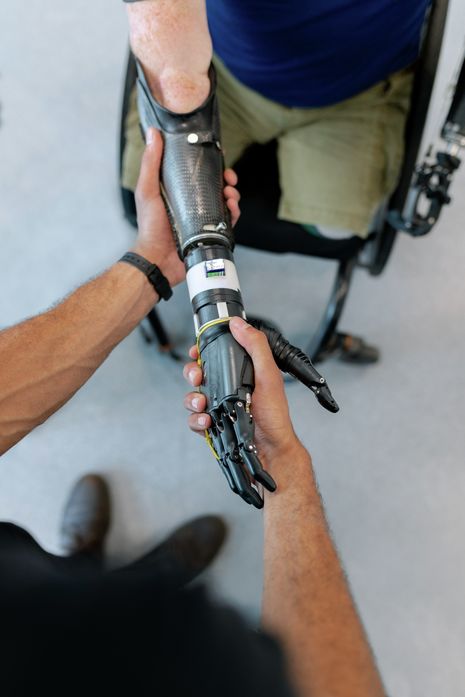Homo novus – can we rebuild the human body?
In the field of healthcare, engineering often seeks to mimic natural function. Sambhavi Sneha Kumar considers whether we can surpass the biological constraints of our bodies.

There is no doubt that the human body is capable of the remarkable. Whether withstanding extreme temperatures or maximising muscular power, our ability to respond to stressful situations can seem almost superhuman. There are limits to what we can achieve in our day-to-day lives – technological advances, however, may allow us to push these limits further.
Engineering often seeks to mimic nature. The imitation of normal physiology is a useful strategy seen in healthcare and there is hope that further development could lead to improved treatment. Ultimately, perhaps, we could even attempt to outperform natural systems.
Limbs
Limb prostheses may be used to replace a limb lost due to trauma, disease, or a congenital disorder. There is a range of different prosthetic techniques available, with neuroprosthetics (connecting the brain to a substitute device) being the most akin to normal organ function. Recently, a four-limb neuroprosthetic robotic exoskeleton allowed for restoration of limb movements controlled by the brain cortex in a tetraplegic patient.
Homo sapiens are generally regarded to be unathletic compared to other species. It has been hypothesised that chimpanzees, our close relatives, may have muscle strength approximately 1.35 times greater than ours, and typically outperform humans in jumping and pulling tasks by 1.5 times on average. This decreased muscular capability is likely due to altered muscle fibre lengths and distributions and forms of the heavy chains of the muscle protein myosin. Humans can enhance skeletal muscular force by muscle hypertrophy through training, but as neuroprosthetic technology develops further there may be even more powerful solutions that could allow us to produce limb movements of strength unreachable with human skeletal muscle.
Eyes
Despite the support that may be available to them, individuals with visual impairment may struggle with lower levels of psychosocial wellbeing when compared to the rest of the population. Vision may be disrupted following traumatic light exposure, by genetic conditions such as retinitis pigmentosa or simply due to old age. Therefore, it is clear why researchers are keen to develop the most effective solution possible.
The Argus II retinal prosthesis became the first approved treatment for retinitis pigmentosa in 2011. It works by using a video camera mounted onto a pair of glasses to capture the wearer's surroundings and transmit signals to a series of electrodes implanted on the surface of the retina. These signals allow for stimulation of remaining photoreceptors and therefore perception of light stimuli by the brain, allowing the patient to 'see' again. Argus II is still relatively new technology but already shows huge promise, improving performance in simple visual tasks in nearly 100% of tested subjects.
Currently, the Argus II camera is only able to detect the visual light region of the electromagnetic spectrum. However, if a camera were used that could 'see' the whole spectrum and convey this to appropriate regions of the brain, Argus II technology could allow us to detect other stimuli such as heat. This could revolutionise how we are able to perceive our surroundings.
'Such technology is often restricted to those who can bear the financial expense.'
However, the Argus II demonstrates an important consideration of such new technological developments in healthcare. It costs approximately 150,000 USD – not including additional costs of the surgical procedure itself and training sessions on how to use the device. It is apparent that it will be difficult to fund wide availability of Argus II. Such technology is often restricted to those who can bear the financial costs.
Skin
With diverse functions ranging from protection against pathogens to thermoregulation, the skin is an organ of huge importance. Extensive wounding, burns, or loss of skin to infection can lead to irreversible damage that requires removal of the affected area and its replacement by a skin graft. A skin graft consists of transplanted skin tissue which may be sourced from a different site on the same individual's body (autograft), from a human donor (allograft) or from an organism of another species (xenograft). However, risks of infection and rejection mean that new developments are continually being investigated.
Three-dimensional printing may offer the answer. This has been previously attempted with little success - due to a lack of vascular networks, the artificial skin substitute often failed to integrate with the host's tissue. However, new methods have used two different bioinks (materials used to produce artificial live tissue) containing the necessary cells for skin layer development and vascularisation. Beyond its direct biological applications, 3D printing is expected to revolutionise the cosmetics industry. For example, devices have been developed that utilise a 3D scanner to analyse a person's skin tone, and then produce the 'perfect' shade of a makeup product using a 3D printer.
Like most systems, the human body has its limitations and can be improved. Much of the new technology developed is done so with the intent of usage within the field of healthcare. However, the potential exists to misuse these advances, perhaps leading to increased severity of violent crimes or inappropriate surveillance. Whilst there is no doubt technology can push our biological limits further, the extent and appropriateness of these developments remain unclear.
 News / Caius mourns its tree-mendous loss23 December 2025
News / Caius mourns its tree-mendous loss23 December 2025 Comment / Yes, I’m brown – but I have more important things to say22 December 2025
Comment / Yes, I’m brown – but I have more important things to say22 December 2025 News / Cambridge welcomes UK rejoining the Erasmus scheme20 December 2025
News / Cambridge welcomes UK rejoining the Erasmus scheme20 December 2025 News / CUP announces funding scheme for under-represented academics19 December 2025
News / CUP announces funding scheme for under-represented academics19 December 2025 News / King appoints Peterhouse chaplain to Westminster Abbey22 December 2025
News / King appoints Peterhouse chaplain to Westminster Abbey22 December 2025









